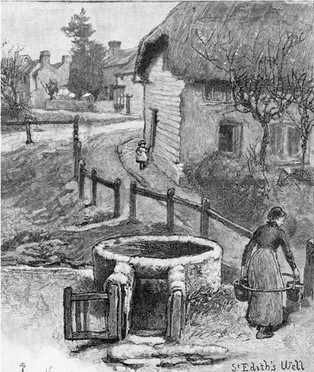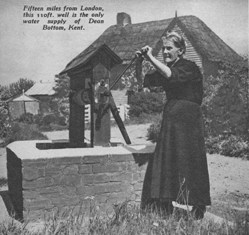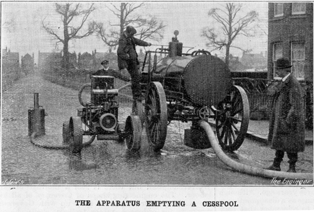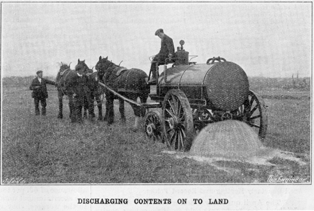Water and Sewerage
Pre-20th century water supply
Hartley has no running water, so all the water has to come from wells and rainwater tanks. Owing to the depth of the watertable wells had to be very deep, and digging them was very dangerous, in 1866 William Flewin died from asphyxiation when digging a well at Fawkham; and in 1884 a Hartley labourer, Henry Offer, was injured when a rope broke as he was being let down at a well digging in Fawkham. They were still vulnerable to giving out in times of drought. Carrying the water from the well to the house was a daily chore and heavy work. The illustration from the Illustrated London News of 1885 shows a woman carrying water from a well at nearby Kemsing. Note the hoop around her waist, this helped to distribute the weight and prevent water from spilling (Coastal Women website). Valerie Porter (Yesterday's Countryside) remembers that drawing water is a skill too, otherwise the bucket will just sit on top of the water!
When the Dartford Rural Sanitary Authority was set up in 1875, one of its early concerns was reasonable access to water supply. In 1881 the owner of Best's Cottages was ordered to lay on a water supply to the four cottages. In 1886 the authority found an outbreak of scrofula at Stocks Farm was down to the tenants having to use a rainwater tank because the well was out of repair. The owner replied that that tank was for livestock and the tenants could walk to nearby wells instead. In reply the authoriity called on him to make the well at Stocks Farm useable.
The lack of water before the 20th century has dictated the development of Hartley. It meant that few cattle were kept on farms because cattle require about 20 times as much water as sheep. It also acted as a brake on building development.
Wells in Hartley
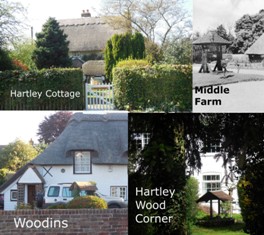 The picture is of a montage of surviving wells in Hartley, but many more are known to have existed. An excellent report with many more details is published in "Record of Wells in the Area Around Dartford" (Betty Harvey and others, NERC 1975)
The picture is of a montage of surviving wells in Hartley, but many more are known to have existed. An excellent report with many more details is published in "Record of Wells in the Area Around Dartford" (Betty Harvey and others, NERC 1975)Fairby, Ash Road. "there are three large tanks for storing rain water from these buildings, and the requisite pumps from same".
Hartley Bottom Farm, Hartley Bottom Road. Well dry by 1944.
Hartley Cottage, Hartley Green. Well still visible. Other houses on the green had a right to draw water from it. Water about 125 feet down.
Hartley Court, Church Road. "there is a tiled wellhouse with triple pump worked by a wind engine, and pumping from a well which has recently been deepened, and a reservoir formed at the bottom by cutting headings, and in addition two reservoir tanks have been built on the surface. Pipes have also been laid (about half-a-mile in length, besides branches) to the Manor House, and to the farm buildings, fields and gardens adjoining.". In the December 1931 Parish Magazine, Rev Bancks wrote: "But there was a time when the houses at the upper end of the village were dependent upon a well at the back of the Court. The water was drawn by a horse, fastened to a pole, one bucket going down as the other came up. Near by was a large stone cistern. This was filled up once a day, and people came with yokes and pails and carried it to their houses. All the wells in the parish, I think, except the one at the Rectory, are now out of action."
Hartley Hill Cottage, Church Road. Well still visible. Water about 130 feet down.
Hartley House, Ash Road. In 1926 the owner allowed it to become a sump to take road surface water. Water about 170 feet down in 1958.
Hartley Manor, Manor Drive. "deep well under cover in front of the house, and exceptionally large rain-water storage"; pump and well with hose (in case of fire). Force-pump for supplying soft water from tanks in one of the kitchens.
Hartley Old Rectory, Ash Road. Very likely built with house in 1851. Water about 90 feet down.
Hartley Wood Corner, Manor Drive. Well still visible.
Middle Farm, Church Road. Well visible in garden. House had rainwater tanks and pump (1901 Sale particulars).
Mintmakers, Church Road. Well marked on 1908 Ordnance Survey map. Probably the well turned into a sump to take road surface water in 1926.
New House Farm, Church Road. Two wells marked on 1936 OS Map. Now part of New Ash Green. Water about 160 feet down.
Old Downs, Castle Hill. Well dug and horse pump installed in 1876 at a cost of £398.
Orchard House (Whiffins Cottage), Church Road. Water about 160 feet down.
Stocks Farm, Church Road. Owner was requested to repair the well here with a rope and kerbing in 1886 (Dartford Rural Sanitary Authority Minutes 1.5.1886)
Woodins, Church Road. Well visible in garden.
Ponds
Rev Bancks, writing in 1927, said over the past 100 years the number of ponds in Hartley had fallen from 17 to 5. Now only two of them remain, although following local government boundary changes, Hartley has acquired a third pond at Red Cow Farm. This loss of ponds is sadly a national trend, Kent alone has lost 500 ponds since 1960. Roadside ponds are known to have existed at:
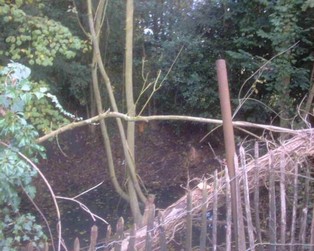 Ash Road: (1) Near junction with Stack Lane (filled in and replaced with hut selling sweets in 1936); (2) Fairby (filled in on road widening in 1935); Hartley House (filled in 1926, water culverted into old well).
Ash Road: (1) Near junction with Stack Lane (filled in and replaced with hut selling sweets in 1936); (2) Fairby (filled in on road widening in 1935); Hartley House (filled in 1926, water culverted into old well).Church Road: (1) Near junction with Stack Lane (filled in with clinker in 1928); (2) Existing pond by Hartley Church (appears on earliest OS map of 1790); (3) Existing pond by Bonsalls (pictured - right); (4) New House Farm
By the 1920s the main purposse for roadside ponds was to take excess surface water from the roads, but it was recognised that this was not ideal. In 1925 the surveyor to Dartford Rural District Council wrote "Ponds are a source of constant trouble; when full, a danger exists and fencing is required; when the water is low they become foul and form a breeding site for mosquitoes. There is also the expense of cleaning out ponds annually.". The council installed the fence at the Church pond in 1932 after requests from local residents.
The roadside pond was a common feature of this part of north Kent where there is no flowing water. A visitor to Longfield in 1873 wrote that the village "is chiefly remarkable for the number of ducks and duck ponds who monopolise the leading thoroughfares".
Hartley pond's primary purpose was for watering of farm animals as they were driven along the roads of Hartley from field to field, or to Dartford cattle market. Rev Bancks wrote "for horses, cattle and sheep passing to and fro they were invaluable". In the West Kent WI book "West Kent within living Memory" are accounts of cattle being driven there through pre-war Bexley. It is possible they were also used for steam engines, certainly the farmyard pond at New House Farm supplied the steam threshing machine there.
Thomas Hardy in Far from the Madding Crowd paints a vivid picture a plough team stopping at a roadside pond in its heyday: "They stopped to drink at a pond on the other side of the way. She watched them flouncing into the pool, drinking, tossing up their heads, drinking again, the water dribbling from their lips in silver threads. There was another flounce, and they came out of the pond, and turned back again towards the farm".
Hartley's roadside ponds are certainly of considerable antiquity. This pond and the pond at the Church Road end of Stack Lane are both marked on the earliest Ordnance Survey map of Hartley in 1790. They were fed by surface run off from the road, but were probably of man made construction at least in part, as they would need a clay lining or "puddling" to prevent water loss and ponds do require regular maintenance. That they were successful in trapping water is clear - in both Hartley and Meopham they were said to be a nuisance because they overflowed onto the road in rainy weather!
Ponds are an important source of wildlife. Charles Ellerby wrote that Hartley's ponds "were a source of great interest to us with their teeming population of newts, tadpoles, dragonflies and infinite varieties of water insects". Children used to collect tadpoles from the Church Road pond.
In the 1930s and 1940s local children loved to play round the Church Road pond and two friends had even put up a swing over the water. In cold winters it would freeze over and they would skate on the ice. In those days the pond was maintained by workers from Harry Smith's farm at West Yoke, who would walk carefully across the pond (to avoid damaging the clay puddling) with their wooden boxes to collect the material to be removed.
Since the war the parish council has on several occasions had the pond repuddled and cleaned, and in 1993 the duckhouse was donated by the Hartley Players. For many years the Church Road pond had fallen into disrepair, but was restored thanks to the effort of local residents led by Ivy Sharp, and the Hartley Village Warden Adam and his colleagues who restored the pond and put in two water proof membranes. The picture shows the official reopening on 7 December 2007.
Dew Ponds
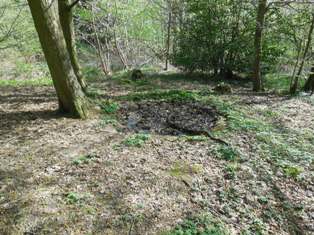 A couple of these of uncertain date can still be seen in Foxborough Wood. Dewponds in spite of their name, were mainly filled by rainwater not condensation. These artificial ponds became popular from the second half of the c19th as a way of providing water for watering livestock on the top of hills where water was scarse. Given their location within the wood and their small size, it is more likely that Hartley's dewponds are connected with encouraging game birds a century ago.
A couple of these of uncertain date can still be seen in Foxborough Wood. Dewponds in spite of their name, were mainly filled by rainwater not condensation. These artificial ponds became popular from the second half of the c19th as a way of providing water for watering livestock on the top of hills where water was scarse. Given their location within the wood and their small size, it is more likely that Hartley's dewponds are connected with encouraging game birds a century ago.Hartley-Kent: Dew Pond in Foxborough Wood
Mains Water
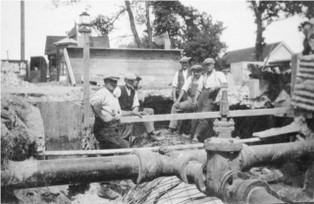 This is one of the milestones in Hartley's development, for mains water enabled far more people to live here than before.
This is one of the milestones in Hartley's development, for mains water enabled far more people to live here than before.While the larger houses had wells or other means of catching water, there were a large number of cottages without their own water.
The Mid Kent Water Order 1901 empowered the company to lay mains to Hartley and the neighbouring parishes. The parish meeting of January 1901 opposed mains water, but it appears this decision was reversed two months later and water arrived the following year. Originally it only went as far as Mintmakers, Church Road, but was extended to the remainder of Church Road in 1913. Other parts had to wait longer; the parish meeting called for mains to be carried along Manor Lane in 1925. Hartley Bottom Road and Hartley Hill mains were laid in 1929, but it appears they may have had a water supply on a 1½ inch pipe before then.
Some remote places still had not got mains water by 1939, this included Dean Bottom on the border of Fawkham and Horton Kirby parishes.
People quickly signed up. In 1915 a Parliamentary Survey found that 48 of Hartley's 66 houses were on the mains, compared with 152/166 for Longfield and 84/128 for Ash parishes. In 1907 the fact of mains water was a selling point for the Payne and Trapps Estate at Wellfield. It is uncertain where the water came from at this time. The owners of land at Gorsewood Road enabled the development of the road by getting Mid Kent Water to lay mains there in 1923.
In 1925 the parish protested about the high charges of the water company (PRO HLG 50/1015); this was followed up by a complaint by Dartford Rural District Council in 1932, which resulted in a 10% reduction in 1933.
According to parish council records the mains were relaid in Hoselands Hill in 1982 and in Church Road/Manor Drive in 1990.
Hartley Pumping Station
A 354 feet deep well, 4 boreholes (and joining adits 2,566 feet long) were sunk into the Chalk in 1938, this was capable of pumping a minimum 1,000,000 gallons per day, tests in 1938 and 1944 found the capacity was 2¼ mgd. The surface catchment area for the station is some 6½ - 7 square miles.
The pumping station came on line in April 1944, but plans to lay a 12" main to the Exedown reservoir were scrapped, instead 1,000 yards of 4" main were quickly laid to Ash. Local power shortages meant that initially it could only pump 0.88 million gallons per day (0.19 mgd to Mid Kent area, and 0.69 mgd to Gravesend).
In 1949 the Minister of Health gave permission to deepen one of the boreholes from 475 feet to 750 feet to tap the underlying Greensand. The station had 4 pumps capable of pumping 22,000 - 47,000 gallons per hour each.
Because of difficulty in recruitment the company decided to build the Cottage in Hartley Bottom Road in 1946.
A routine analysis of the water in 1967 found the water was "clear and bright", which may come as a surprise to those of us who remember the snowstorm in a glass of water of those days. For a chalk area it was unsurprisingly alkaline (pH 7.2). The main trace solids being Calcium (248 parts per million), Magnesium (12 ppm), Silica (14 ppm). Then the water was very slightly chlorinated. (Refs: TNA HLG 127/464, HLG 23/27531)
The Hartley Water Committee was abolished in 1973, by section 33 of the Water Act 1973.
Sewerage
Before mains drainage people in the rural areas relied on earth closets and cess pools. Others buried sewage in the garden or put it with household slops in garden slop pools (Report of R Deane Sweetly to Diptheria Outbreak in Dartford Rural Area, 1899, TNA MH12)
The threat of disease from untreated sewage was a great concern, particularly in the 1890s when there were a number of diptheria outbreaks, including Hartley in 1898. In 1895 the Dartford Rural District Council decided to start removing refuse and emptying cesspools, charging the cost to the rates. It appears this measure to improve public health was bitterly opposed by Hartley and Longfield, Mr Barnes wrote to the Local Government Board to complain on behalf of the parish meeting. He said it was "one of the most scandalous that has ever been made". He argued that it would only benefit the urban areas, and wasn't needed in Hartley with its large gardens. Longfield parish submitted a 27 signature petition. However Hartley had relented by 1897.
Sewage was pumped out of cesspools and the contents sprayed on fields. See illustrations of cesspool emptying and muck spreadingat Colnbrook, Middx in 1915.
Peter Goodwin recalls seeing muck spreading at Northfield, which was opposite his house: "Later I remember corn and cabbages and, now and again, a fallow year, in those days a field was allowed to rest and recuperate about every 4 years, I think. Then the 2 wheeled farm carts pulled by shires would tip heaps of real manure over the field, which was spread by hand forks. Hence the phrase muck spreading, now done by machine. If memory serves me rightly, the council sewage wagon would also empty its contents on the field (from household cesspits which had to be emptied). This was all ploughed in."
From 1907 to 1942 responsibility for emptying cesspools and collecting rubbish was undertaken by the Ash and District Joint Sanitary Committee. The Rural District Council took over in 1942.
Mains sewerage was first planned as a post war priority by the Dartford Rural District Council in 1944 at an estimated cost for Hartley and Longfield of £46,000 - but it was not until 1960 that mains seweres were laid onto to Ash Road, and Church Road followed in 1963 after some problems with the bankruptcy of the contractors. There are still some properties on cesspool drainage, most notably the Manor Field Pavilion.
Overflowing sewers have caused problems on occasion, particularly in Church Road, where problems have occurred in 1975, 1985, 1993 and 1999.

